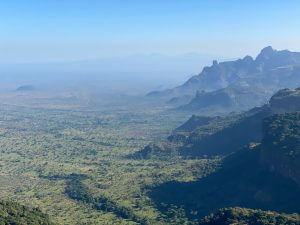Located in the rugged and captivating landscapes of the Karamoja region in northeastern Uganda, mountain Kadam is a part of the Pian-upe Wildlife Reserve and is home to many tribes, including the Kadama, Sebei Pokot, Karamojong, Gishu, and Tepeth.
Mount Kadam stands as a majestic symbol of natural beauty and cultural significance.
The mountain’s imposing presence, diverse flora and fauna, and rich cultural heritage make it a compelling destination for adventurers and nature enthusiasts alike.
Rising to an elevation of approximately 3,063 metres, Mount Kadam offers an awe-inspiring backdrop of rolling hills, verdant valleys, and dramatic rock formations.
The mountain is surrounded by an intriguing ecosystem, including lush forests, expansive grasslands, and crystal-clear streams, creating an ideal habitat for a wide variety of wildlife.
The region surrounding Mount Kadam is home to several indigenous communities, notably the Karamojong people, whose ancient traditions and way of life are deeply entwined with the mountain and its environs.
Visitors to the area have the privilege of immersing themselves in the unique cultural tapestry of the Karamoja people, experiencing their music, traditional dances, and distinctive way of life.
The allure of Mount Kadam extends beyond its natural splendour and cultural vibrancy.
The mountain and its rare endemic species, such as the De Brazza’s monkey, Uganda kob, Jackson’s hartebeest, and a plethora of bird species, find refuge in this pristine environment.
Trekking and hiking opportunities abound in the vicinity of Mount Kadam, offering adventurers the chance to explore the undulating terrain, traverse lush forests, and revel in panoramic vistas from elevated vantage points.
The ascent to the mountain’s summit rewards hikers with breathtaking views of the surrounding landscape, where the plains of Karamoja stretch out to the horizon and the distant peaks of the Karamoja region create a mesmerising tableau.
Conservation efforts have been pivotal in safeguarding the natural heritage of Mount Kadam and the Karamoja region as a whole.
Local initiatives and international collaborations have focused on preserving the diverse ecosystems, protecting endangered species, and promoting sustainable livelihoods for the communities residing in the area.

